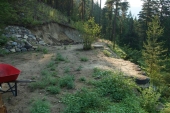
 1
1




 1
1




 ) to live there ? What are your long term plans
) to live there ? What are your long term plans 
Living in Anjou , France,
For the many not for the few
http://www.permies.com/t/80/31583/projects/Permie-Pennies-France#330873





The property is about an acre. The back yard is about two thirds of that. It is all lawn, with a few trees scattered around, but the bulk is open grass. The rear property line is about ten feet inside a forest that goes several miles. The wood line is overgrown vines and small brush that I have not identified.
Soil: I installed one 4x8 bed over a bare spot. I tilled about a foot deep with a shovel before adding my actual bedding fill on top of it. The soil is very sandy. It is white about a half inch, black about six inches, then turns reddish another six. I can shape it into a ball, but it is still crumbly and dries fast. In super heavy rain, the whole yard pools a quarter inch or so, then drains in less than an hour. I have not determined anything else about water movement.
List of Bryant RedHawk's Epic Soil Series Threads We love visitors, that's why we live in a secluded cabin deep in the woods. "Buzzard's Roost (Asnikiye Heca) Farm." Promoting permaculture to save our planet.




















List of Bryant RedHawk's Epic Soil Series Threads We love visitors, that's why we live in a secluded cabin deep in the woods. "Buzzard's Roost (Asnikiye Heca) Farm." Promoting permaculture to save our planet.
 1
1




















List of Bryant RedHawk's Epic Soil Series Threads We love visitors, that's why we live in a secluded cabin deep in the woods. "Buzzard's Roost (Asnikiye Heca) Farm." Promoting permaculture to save our planet.




Medicinal herbs, kitchen herbs, perennial edibles and berries: https://mountainherbs.net/ grown in the Blue Mountains, Australia




Yes, I'm that David The Good. My books are here: http://amzn.to/2kYcCKp. My daily site is here http://www.thesurvivalgardener.com and my awesome videos are here https://www.youtube.com/subscription_center?add_user=davidthegood

|
You ought to ventilate your mind and let the cobwebs out of it. Use this cup to catch the tiny ads:
Back the BEL - Invest in the Permaculture Bootcamp
https://permies.com/w/bel-fundraiser
|




